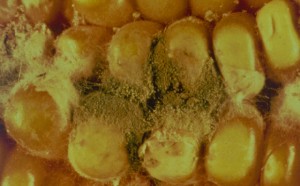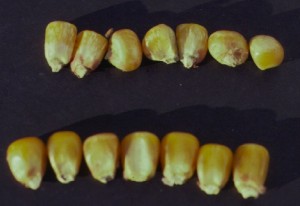Mycotoxins in Corn
go.ncsu.edu/readext?355884
en Español / em Português
El inglés es el idioma de control de esta página. En la medida en que haya algún conflicto entre la traducción al inglés y la traducción, el inglés prevalece.
Al hacer clic en el enlace de traducción se activa un servicio de traducción gratuito para convertir la página al español. Al igual que con cualquier traducción por Internet, la conversión no es sensible al contexto y puede que no traduzca el texto en su significado original. NC State Extension no garantiza la exactitud del texto traducido. Por favor, tenga en cuenta que algunas aplicaciones y/o servicios pueden no funcionar como se espera cuando se traducen.
Português
Inglês é o idioma de controle desta página. Na medida que haja algum conflito entre o texto original em Inglês e a tradução, o Inglês prevalece.
Ao clicar no link de tradução, um serviço gratuito de tradução será ativado para converter a página para o Português. Como em qualquer tradução pela internet, a conversão não é sensivel ao contexto e pode não ocorrer a tradução para o significado orginal. O serviço de Extensão da Carolina do Norte (NC State Extension) não garante a exatidão do texto traduzido. Por favor, observe que algumas funções ou serviços podem não funcionar como esperado após a tradução.
English
English is the controlling language of this page. To the extent there is any conflict between the English text and the translation, English controls.
Clicking on the translation link activates a free translation service to convert the page to Spanish. As with any Internet translation, the conversion is not context-sensitive and may not translate the text to its original meaning. NC State Extension does not guarantee the accuracy of the translated text. Please note that some applications and/or services may not function as expected when translated.
Collapse ▲Toxic metabolic by-products of fungi, known as mycotoxins, have received considerable attention during the past several years. Mycotoxins are known to cause serious health problems in animals including equine leukoencephalomalacia in horses and porcine edema in swine. Reduced weight gain, capillary fragility, reduced fertility, suppressed disease resistance, and even death have been attributed to mycotoxins. No animal is known to be resistant, but in general, older animals are more tolerant than younger animals. Some mycotoxins, fumonisin, aflatoxin, and ochratoxin in particular; have also been associated with human health problems. Certain mycotoxins are suspected carcinogens.
The mycotoxins reported to occur in corn are listed in table 1. The most commonly found mycotoxins in North Carolina-grown corn are aflatoxin, fumonsin, and deoxynivalenol (DON). Probably the most familiar of these is aflatoxin. The detection of aflatoxin in corn can result in a reduced price for grain or even rejection. A mycotoxin of more recent concern is fumonisin. Some corn containing greater than 15 parts per million (ppm) fumonisin was rejected in North Carolina in 1998. Contamination of corn with mycotoxins is greatly influenced by weather.
Aflatoxin in Corn
The fungus Aspergillus flavus (Fig. 1) produces the mycotoxin known as aflatoxin on a number of crops including corn, peanut, and cotton. Typically, the fungus has a yellow green appearance when it is growing on corn kernels. The fungus is quite common in nature, but its population increases during hot dry weather. Aflatoxin contamination is greater in corn that has been produced under stress conditions. Thus, drought, heat, insect, nematode, and fertilizer stress are all conducive to high levels of aflatoxins. Seed companies are in the process of developing corn hybrids with some level of resistance to the fungus or that have less tendency to accumulate the toxin. Although these hybrids will tend to have lower levels of aflatoxin than others grown under the same conditions, complete resistance is unlikely. Management practices such as irrigation, good insect control and timely fertilization may reduce stress to the corn plant and thus lower aflatoxin levels.
Aflatoxin levels are regulated by the Food and Drug Administration (FDA) at 20 ppb (parts per billion) in food and feed. Aflatoxin can also appear in milk of lactating animals fed aflatoxin-contaminated feed. The allowable limit in milk is 0.5 ppb.
Fumonisins in Corn
Fumonisins are a group of mycotoxins produced by fungi in the genus Fusarium. The fungusFusarium moniliforme (Fusarium verticillioides) is a common pathogen of corn, so common in fact that it is found wherever corn is grown. Fusarium moniliforme usually appears white to salmon colored, although it may not be visible on the corn kernel. This fungus often produces a symptom on the corn kernels referred to as “starburst,” or a white streaking of the kernel (Fig. 2). The visual absence of mold, however, does not mean that kernels do not contain the toxin. Intact corn kernels may contain the fungus and the toxin but show no sign of the fungal contamination. In severe cases, the corn shucks will become “glued” to the kernels in the cob.
Fumonisins have been implicated as a possible cause of human esophageal cancer, equine leukoencephalomalacia (ELEM), a serious disease in horses, and porcine edema – a disease in swine. Poultry and cattle are not especially susceptible to fumonisins. However, caution should be used in feeding moldy corn to these animals as other mycotoxins may also be present in rotted or moldy corn. Fumonisins were found at levels above 5 ppm in 23.5 % and 31.0% of suspect grain samples in North Carolina in 1992 and 1993 respectively. Contamination with fumonisins was more severe in 1998, and corn with fumonisin levels in excess of 15 ppm was rejected by some buyers. Currently, no levels for fumonisins have been set by the FDA, but they will likely be less than 5 ppm for human consumption and horses. Buyers of corn used in feed may accept grain with higher levels of fumonisins than those recommended, depending on what portion of the feed ration is corn. Also, corn and corn products shipped to Europe may be regulated at a lower level in the future.
Currently there are no corn hybrids resistant to the fungus F. moniliforme, which is the principle producer of fumonisins. Some hybrids may be more susceptible to Fusarium than other hybrids, but no hybrid is known to be completely resistant. Dry weather early in the season, followed by wet weather during silking of the corn plant, and insect infestation increase the amount of fungal infection of corn kernels. Typically, infection by F. moniliforme will not greatly affect the yield of corn. However, if conditions favorable for fungal growth continue up to harvest, fumonisin levels in harvested corn may exceed recommended levels for certain animals. Factors that influence fumonisin production in corn are not well understood at this time. Certainly, insects provide an avenue of infection for both Aspergillus and Fusarium. Hybrids genetically engineered to resist insects may have lower levels of fumonisins. Also, research is under way in the corn industry to engineer plants with an enzyme to degrade fumonisins.
Deoxynivalenol
Deoxynivalenol (DON or vomitoxin) is a mycotoxin produced by certain species of Fusarium, the most important of which is F. graminearum (Gibberella zeae). This fungus causes Gibberella ear (also known as red ear rot) or stalk rot on corn and head scab in wheat. The fungus itself appears reddish to pinkish. The fungus may cause a reddish dicoloration of the cob and kernels.
The mycotoxin deoxynivalenol causes reduced weight gain and suppresses animal feeding, especially in swine. At high concentrations (greater than 10 ppm) vomiting and total feed refusal may occur. FDA has recomended that total feed levels of DON not exceed 5 ppm for cattle and chicken, and 1 ppm for swine. DON levels for human food should be less than 1 ppm.
Red ear rot caused by F. graminearum is favored by warm wet weather after silking. Disease tends to be worse when corn is grown without rotation or after wheat as this pathogen also infects wheat. It may be worse when corn is grown in reduced tillage situations.
Management
Both A. flavus and F. moniliforme are widely distributed in nature and are favored by high temperature. Temperatures ranging from 80 to 100 degrees F and a relative humidity of 85 percent (18 to 20 percent moisture in the grain) are optimum for fungal growth and toxin production. Growth of these fungi does not occur below 12 to 13 percent moisture in the grain. In order to minimize the level of mycotoxins in corn, the following practices should be followed:
- Use recommended crop production practices.
- Plant early.
- Irrigate to reduce drought stress.
- Minimize insect damage.
- Harvest early.
- Avoid kernel damage during harvest.
- Dry and store corn properly – 13 % or less moisture.
- Keep storage facilities clean.
- Dispose of corn screenings – do not feed to animals.
The North Carolina Department of Agriculture will test feed or grain samples for levels of fumonisins for a $75.00 fee. Testing for aflatoxin is free. Samples should be sent to:
NCDA&CS
Consumer Services
Food and Drug Protection Division
4000 Reedy Creek Rd.
Raleigh, NC 27607
At least two companies, Neogen Corporation (1-800-234-5333), and VICAM (1-800-338-4381), market kits for testing for fumonisins. More information on the effects of mycotoxins is available from the North Carolina Cooperative Extension Service through the publication AG-523 – Understanding and Coping with Effects of Mycotoxins in Livestock Feed and Forage.
References
Compendium of Corn Diseases. Third Edition. The American Phytopathological Society, St Paul, MN.
CAST. 1999. Mycotoxins, Economic and Health Risks. Council for Agricultural Science and Technology Task Force Report R132.
Munkvold, G.P., and Desjardins, A.E. 1997. Fumonisins in maize: Can we reduce their occurrence? Plant Disease 81-556-565.
Munkvold, G.P., and Hellmich, R.L. 1999. Comparison of fumonisin concentrations in kernels of transgenic bt maize hybrids and nontransgenic hybrids.
Payne, G.A. 1998. Process of contamination by aflatoxin-producing fungi and their impact on crops. In K.K. Sinha dnd D. Bhatmayas. Moycotoxins in Agriculture and Food Supply. Marcel Dekkar, New York, NY.
Table 1. Some mycotoxins, fungi that produce them and symptoms in animals consuming feed contaminated with them.
| Mycotoxin | Fungi associated | Symptoms/toxicology |
|---|---|---|
| Aflatoxin | Aspergillus flavus, A. parasiticus | liver necrosis, liver tumors, reduced growth, depressed immune response, carcinogen |
| Fumonisin | Fusarium moniliforme, F. proliferatum | equine leukoencephalomalacia, porcine pulmonary edema |
| Deoxynivalenol (DON) | F. graminearum | feed refusal, reduced weight gain, diarrhea, vomiting |
| Trichothecenes | F. graminearum, F. culmorum, F. poae | alimentary toxic aleukia, necrosis, hemorrhages, oral lesion in broiler chickens |
| Ochratoxins | Penicillium verrucosum, Aspergillus ochraceus | porcine nephropathy; various symptoms in poultry |
| Citrinin | Penicillium sp., Aspergillus sp. | kidney damage |
| Cyclopiazonic acid | Penicillium sp., Aspergillus sp. | neurotoxin |
| Sterigmatocystin | Aspergillus sp., and others | carcinogen, mutagen |
 Figure 1. The fungus Aspergillus flavussporulating on corn. |
 Figure 2. Corn kernels infected with Fusarium moniliforme (upper row) showing “starburst” symptom. |
For assistance with a specific problem, contact your local North Carolina Cooperative Extension center.
Originally published as a Corn Disease Information Note authored by Steve Koenning, Plant Pathology Extension Specialist and Gary Payne, Professor of Plant Pathology.


